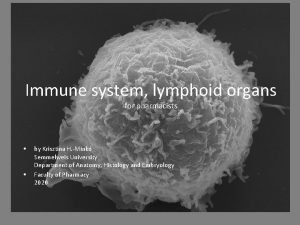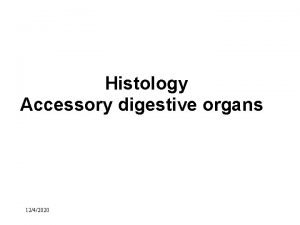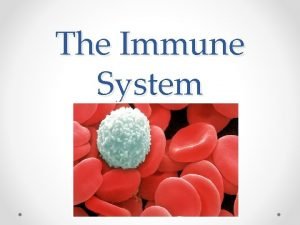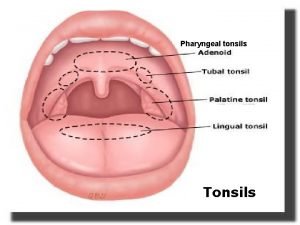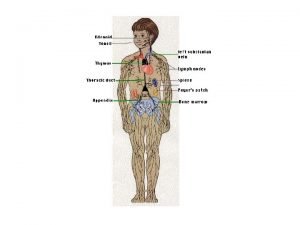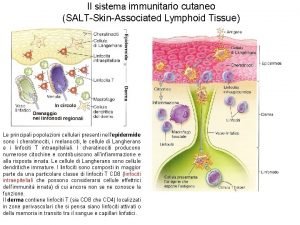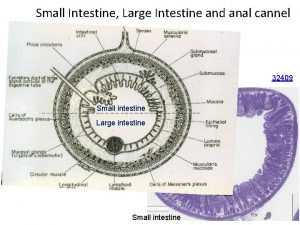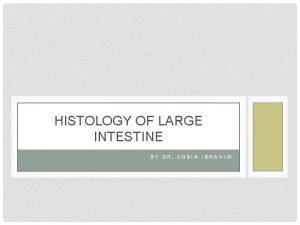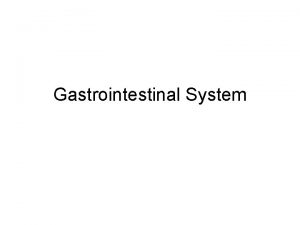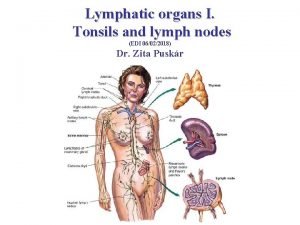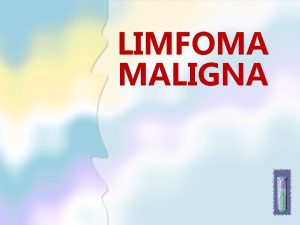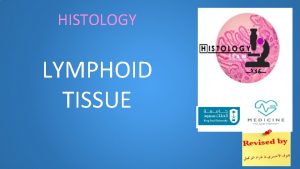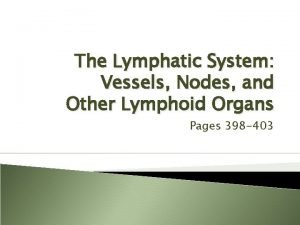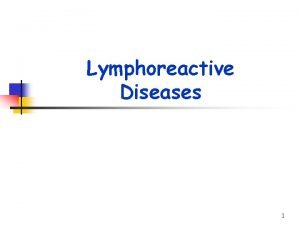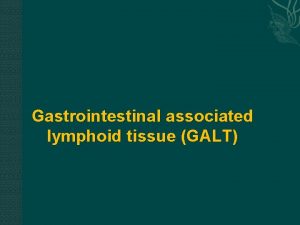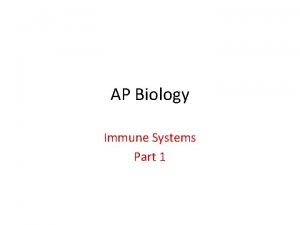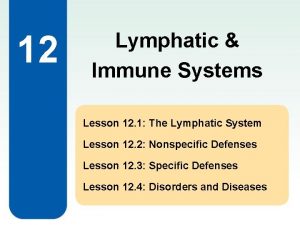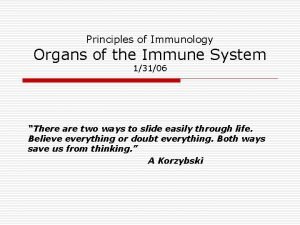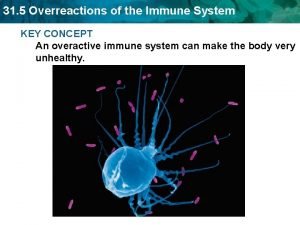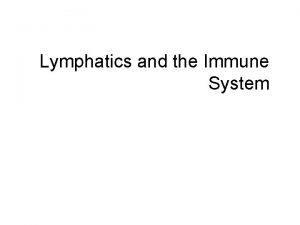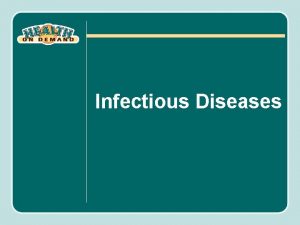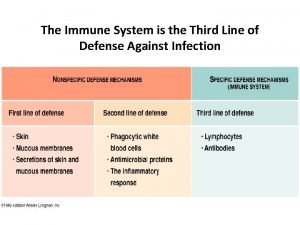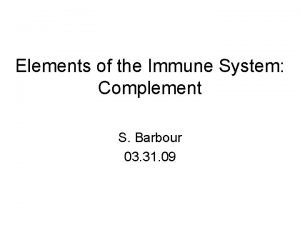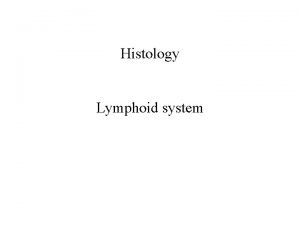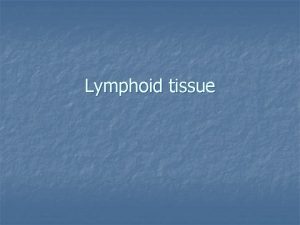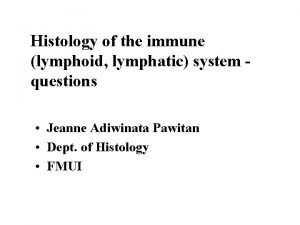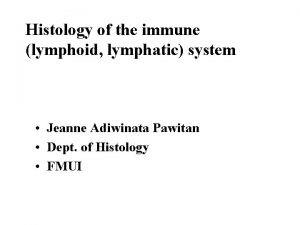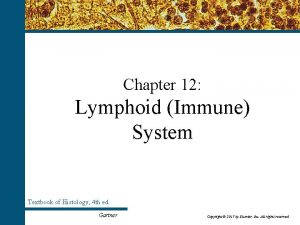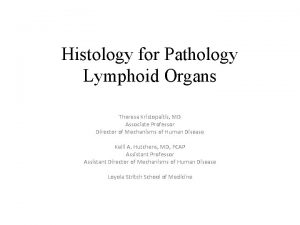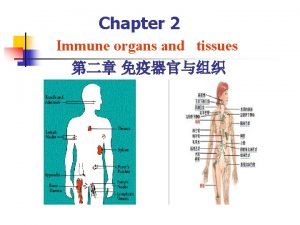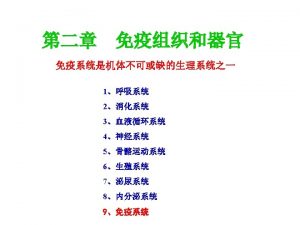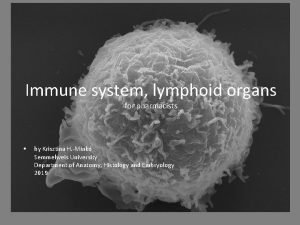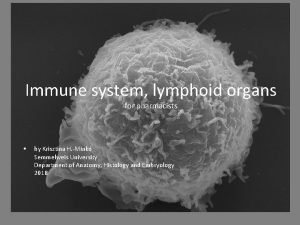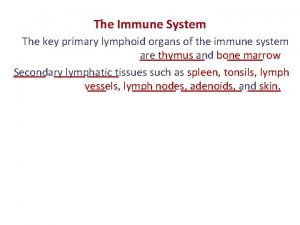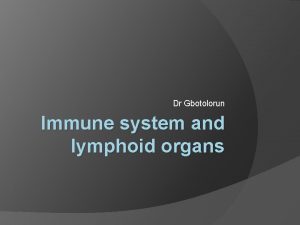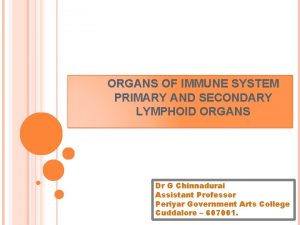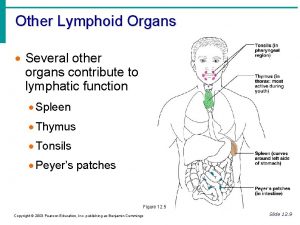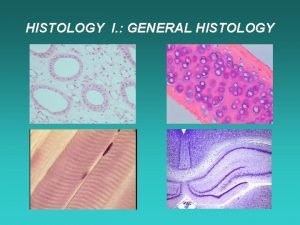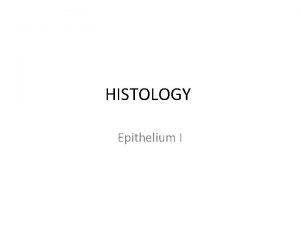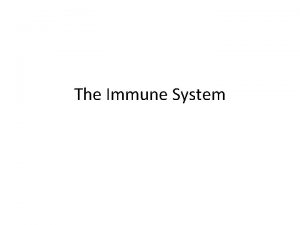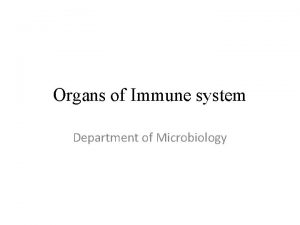Histology of Lymphoid Organs Immune system The immune











































- Slides: 43

Histology of Lymphoid Organs

Immune system • The immune system is the body's defense against infectious organisms, organs include thymus, bone marrow, lymph nodes, spleen and palatine tonsils. • The first line of defence consists of skin and mucosal linings of alimentary, respiratory and urogenital system. • Types of immune system : Innate immune system Adaptive immune system

Innate Immune System • • • Natural or nonspecific immune system Second line defence against harmful agents Responds is rapid within few hours Has no immunological memory Consists of proteins, peptides, cytokines, phagocytic cells and natural killer cells.

Adaptive Immune System • • • Specific immune system Third line of defence Responds slower than innate immune system Has immunological memory Consists of B lymphocytes , T lymphocytes and antigen presenting cells.

Antigen is a harmful substance which enters the body which causes the body to make antibodies as a response to fight off disease. OR A substance that is capable of stimulating an immune response, specifically activating lymphocytes. Antibody also known as an immunoglobulin (Ig), is a large, Yshaped protein produced mainly by plasma cells that is used by the immune system to neutralize pathogens such as bacteria , viruses and other toxic substance.

Lymphoid Organs Central (primary) lymphoid organ: Where lymphatic cells are formed and matured. – T cells in thymus – B cells in bone marrow Peripheral (secondary) lymphoid organ: Whenever there is an antigenic stimulation, their lymphocytes increase in number and take part in the immune response against the antigen. Including lymph nodes, spleen and tonsils.

Lymph Nodes

• Entire node is bean shaped • The concavity constituting a hilum through which blood vessels enter and leave the node • Several lymph vessels enter the node on its convex aspect • Usually a single lymph vessel leaves the node through its hilum.


• Each lymph node consists of – Capsule connective tissue framework densely packed collagen fibers – Parenchyma Outer darkly stained Cortex Inner lightly stained Medulla

The connective tissue framework The lymph node is surrounded by a pericapsular adipose tissue that contains arterioles and venules. The lymph node is covered by a capsule consisting mainly of collagen fibres. Some elastic fibres and some smooth muscles may be present.

A number of septa/trabeculae extend into the node from the capsule and divide the node into the lobules The hilum is occupied by a mass of dense fibrous tissue

Lymph node


• On section, – The node has an outer zone containing densely packed lymphocytes, stains darkly • Cortex does not extend into the hilum

• Surrounded by the cortex, there is a lighter staining zone in which lymphocytes are fewer • Medulla


• Within the cortex The cortex can further divided into two regions Outer region contains lymphatic nodules known as nodular cortex Inner region is free of lymphatic nodules called paracortex or deep cortex The cortex contains numerous lymphocyte aggregations called lymphatic follicles or lymphatic nodules. Each nodule has a paler staining germinal centre surrounded by a zone of densely packed lymphocytes.

Lymph node



• Within the medulla The lymphocytes are arranged in the form of branching and anastomosing cords known as medullary cords containing B lymphocytes, plasma cells and macrophages. The medullary cords interspersed with medullary sinuses that drain lymph from the node into the efferent vessels at the hilus.

Lymph node

Medullary cord and sinus


• Central lymphoid organ • Present in the superior and anterior mediastinum of thorax

It is bilobed organ Each lobe has a connective tissue capsule Connective tissue septa passes inward Subdivide the lobe Lobule has an outer cortex & inner medulla



Thymic Cortex In the cortex of each lobule the epithelioreticulur cells is densely packed with T lymphocytes also known as thymocytes. Lymphatic nodules are not present in the normal thymus. There are three types of epithelioreticulur cells present in cortex. Type I epithelioreticulur cell (located in outer cortex) Type II epithelioreticulur cell (located in midcortex) Type III epithelioreticulur cell (located at the juction of cortex and medulla)

Thymic medulla • The medulla , inner portion of thymic lobule contain fewer T lymphocytes and a large number of epithelioreticular cells. • Three types of epithelioreticular cells are present. Type IV epithelioreticular cells Type VI epithelioreticular cells

Thymus

Corpuscles of Hassall • Small rounded structures present in the medulla of the thymus • Has a central core formed by epithelial cells • Around this mass there is a wall formed by concentrically arranged epithelial cells


Thymus

• Stem cells formed in bone marrow travel to the thymus • Here they come to lie in the superficial part of the cortex, & divide repeatedly to form small lymphocytes known as thymocyte. • About 95% of thymocytes produced in the thymic cortex fail to become properly immunocompetent. • Only 5% have received proper thymic education and become properly immunocompetent T lymphoctes.

• As lymphocytes divide they pass into the cortex, & into the medulla • They leave thymus by passing into blood vessel and lymphatics


• The central mass also contains degenerating macrophages

MCQS Q. 1 When looking at a lymph node, where are lymphatic nodules? a. Deep cortex b. Tertiary cortex c. Medulla d. Paracortical zone e. Outer cortex

Q 2. What is another term for lymphatic nodules? a. Lymph follicles b. White pulp c. Peyer's patches d. Lymph node e. Diffuse lymphatic tissue

Q 3. Which of the following is composed of epithelioreticular cells? a. Spleen b. Thymus c. Bone marrow d. Lymph node e. None of the above

Q 4. What are the spherical structures seen in the medulla of the thymus called? a. Psammoma bodies b. Corpora arenacea c. Hassall's corpuscles d. Prostatic concretions e. Pacinian corpuscles
 Central lymphoid organs
Central lymphoid organs Generative lymphoid organs
Generative lymphoid organs Lymphoid
Lymphoid Nodus lymphaticus histology
Nodus lymphaticus histology Lymph node labeled diagram
Lymph node labeled diagram Lymphatic tissue
Lymphatic tissue A subsequent
A subsequent Sinusoids
Sinusoids Enlargement of a lymphoid organ in the luq
Enlargement of a lymphoid organ in the luq Largest lymphoid organ
Largest lymphoid organ Lymphatic tissue in pharynx
Lymphatic tissue in pharynx Lymphoid tissue in large intestine
Lymphoid tissue in large intestine Salt skin associated lymphoid tissue
Salt skin associated lymphoid tissue Function of lymphatic system
Function of lymphatic system Lieberkuhn
Lieberkuhn Histology of large intestine
Histology of large intestine Crohn's disease
Crohn's disease Thymus gland
Thymus gland Stratified squamous non-keratinized epithelium
Stratified squamous non-keratinized epithelium Jaringan limfoid
Jaringan limfoid Lymphoid tissue
Lymphoid tissue Lymphoid
Lymphoid Feline histiocytosis
Feline histiocytosis Immunity organized
Immunity organized What is the third line of defense in the immune system
What is the third line of defense in the immune system Blood cells flow chart
Blood cells flow chart Any substance capable of provoking an immune response
Any substance capable of provoking an immune response Innate immunity first line of defense
Innate immunity first line of defense Chapter 35 immune system and disease
Chapter 35 immune system and disease 1st 2nd and 3rd line of defense immune system
1st 2nd and 3rd line of defense immune system Ap bio immune system
Ap bio immune system Lesson 12 blood and immune system
Lesson 12 blood and immune system Lesson 12 blood and immune system
Lesson 12 blood and immune system Oobean
Oobean Immunity assignment slideshare
Immunity assignment slideshare Overreactions of the immune system
Overreactions of the immune system Lymphatic vs immune system
Lymphatic vs immune system Lymph return
Lymph return Defination of immune system
Defination of immune system Third line of defense
Third line of defense The main function of immune system
The main function of immune system Thymus immune system
Thymus immune system Immune complex
Immune complex Immune system structure
Immune system structure



